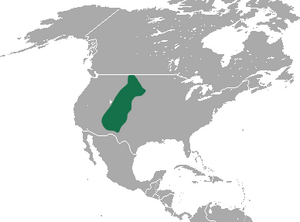Dwarf shrew facts for kids
Quick facts for kids Dwarf shrew |
|
|---|---|
| Conservation status | |
| Scientific classification | |
 |
|
| Dwarf shrew range |
The dwarf shrew (Sorex nanus) is a tiny mammal that belongs to the shrew family called Soricidae. These small creatures live only in certain parts of the United States. You can find them in states like Arizona, Colorado, Montana, Nebraska, New Mexico, South Dakota, Utah, and Wyoming. The very first dwarf shrew ever studied was found in Estes Park, Colorado.
Contents
What Does a Dwarf Shrew Look Like?
As its name suggests, the dwarf shrew is a very small animal. It usually weighs only about 1.8 to 3.2 grams. That's about as light as two paper clips!
This shrew changes its fur, called pelage, with the seasons. This helps it hide from animals that might try to eat it. In the summer, its fur is brown or olive-brown on its back. This color blends into a smoky gray on its belly. Its tail has two colors: dark fur on top and light beige fur underneath.
When winter comes, the dwarf shrew's fur becomes lighter and grayer. This change helps it blend into its surroundings, especially in snowy or colder areas.
How Dwarf Shrews Are Related to Other Animals
Scientists often study how different animals are related to each other. This is called phylogeny. For the dwarf shrew, figuring out its family tree has been a bit tricky. There are many species in the Sorex group, and they can look very similar.
However, many scientists now agree on a theory. They believe the dwarf shrew (S. nanus) came from an older shrew species called S. vagrans. Other shrews like S. longirostris and S. ornatus also came from S. vagrans. Scientists also think that S. nanus and S. tenellus are very close relatives. They look so much alike that it's hard to tell them apart, except for tiny size differences.
Where Do Dwarf Shrews Live?
Dwarf shrews mostly live in mountain areas. They can be found in the Rocky Mountains and other mountain ranges. They usually live at high elevations, but sometimes they come down to lower areas, around 1,400 to 1,500 meters high.
We don't know everything about where dwarf shrews live. They are often found in rocky places, like cold, high-altitude grasslands (alpine tundra) and forests with cone-bearing trees (subalpine coniferous forests). It seems they don't handle very dry places better than other shrews.
However, dwarf shrews have also been seen in surprising places. They've been found on dry, brushy slopes in Colorado. They also live in areas with sagebrush and grass in Montana. Some have even been seen in the Black Hills of South Dakota. These different locations make their distribution a bit of a mystery!
Scientists have found fossils of dwarf shrews. These old remains were discovered in caves in New Mexico and Idaho. This shows they have lived in these regions for a very long time.
In the past, people thought dwarf shrews were very rare. From 1895 to 1966, only 18 sightings were recorded. But then, a study on frogs in 1966 accidentally caught 24 dwarf shrews! This showed they might not be as rare as once thought. One reason they were considered rare is that they live in scattered areas across North America. Also, they are easily confused with other shrews that look very similar.
See also
 In Spanish: Sorex nanus para niños
In Spanish: Sorex nanus para niños


